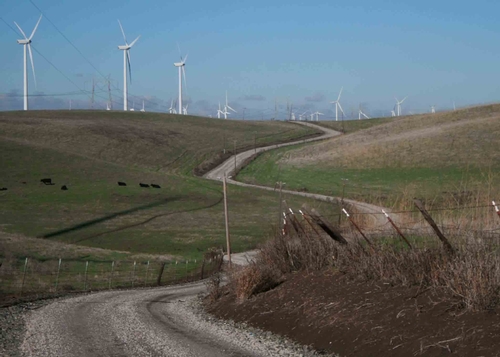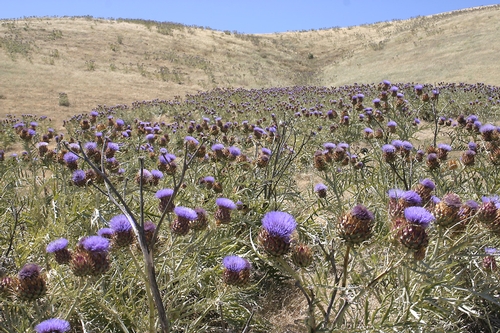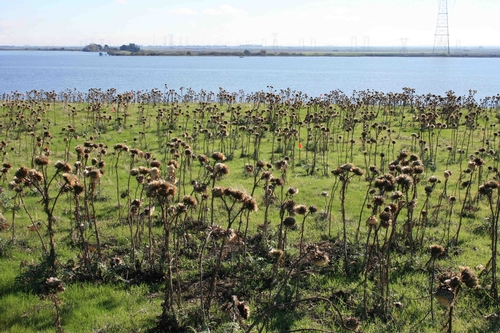Last week I visited one of my favorite experimental sites: the SMUD wind farm in the Montezuma Hills, at the south edge of Solano County. The site overlooks the Sacramento River where it’s a half-mile wide. If you tripped over the back end of Plot #60 and rolled down the hill into the river and floated down through the delta for twenty miles, you’d get to Benicia and the Ghost Fleet.
This is a weird landscape of treeless hills dotted with black cows. To the west is a staggered row of four-hundred foot wind turbines, slowly rotating (if they’re turning fast, then it’s too windy to spray weeds). To the east is a twenty-acre patch of tall, spiny, silvery-colored artichoke thistles. I am here to kill them.

Artichoke thistle (Cynara cardunculus) is an escaped wild biotype of cultivated artichoke or cardoon. In its native Mediterranean region, artichoke was once just a huge, spiny, perennial thistle until some hungry genius tried boiling one of the flower heads for antipasto. Centuries of breeding and selection gave us the modern cultivated version. Farmers keep artichokes “tame” (productive, non-spiny) by making cuttings of clones with favorable characteristics, or by carefully monitoring seedhead pollination. Outside of cultivation, artichokes pollinate freely, and after a few generations of outcrossing and natural selection they revert to their spiny wild type.

This plant invades low-elevation rangeland in the foothills around the Sacramento Delta and the San Francisco Bay Area. Once artichoke gets established, it spreads into a dense, spiny patch. Cattle avoid grazing it, and the patch keeps getting bigger. Cattlemen, recreational area managers, and natural resource districts all want to get rid of this plant.
I’ve talked to several land managers in this area who control individual artichokes with Milestone® or Roundup® herbicide in a spot treatment, using a spray gun running off an ATV. Sounds like fun. The downside is that spot treatments like this won’t control the artichoke seedbank over the broader area.
In our study, we made broadcast treatments with selective herbicides such as Milestone® and Perspective®. These chemicals burn down the standing plants (postemergence activity), and also have a 3 to 5 month soil residual, so they control germinating seeds (preemergence activity). Most important, they are also selective for broadleaf plants, meaning they should be able to take out the artichoke without hurting the grasses. The combination of selectivity and pre + postemergence activity means we can apply these chemicals broadcast, over a whole patch, and control artichoke for a year. (May take a few more applications to deplete the artichoke seedbank.)
We know these chemicals are effective against other thistles (e.g., yellow starthistle, Russian knapweed, Italian thistle). The questions here are
(1) How effective are these treatments against artichoke?
(2) What is the minimum effective rate of herbicide we can use?
(3) What is the most effective timing?
The last question, timing, is the most interesting for me, since other perennial weeds respond differently to herbicides depending on the time of year.
Some results & discussion next time.
